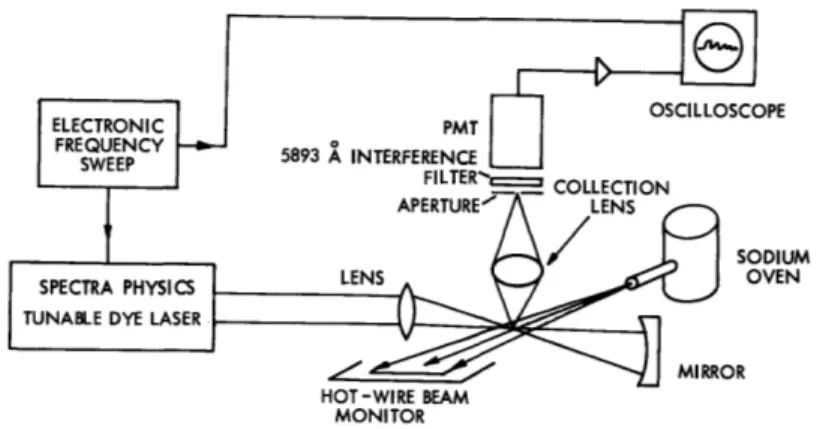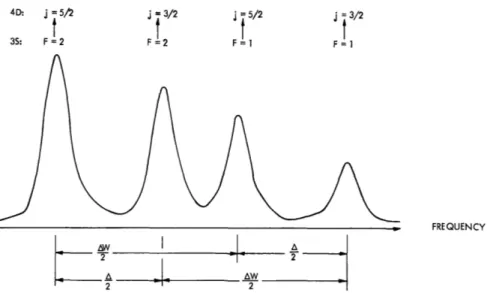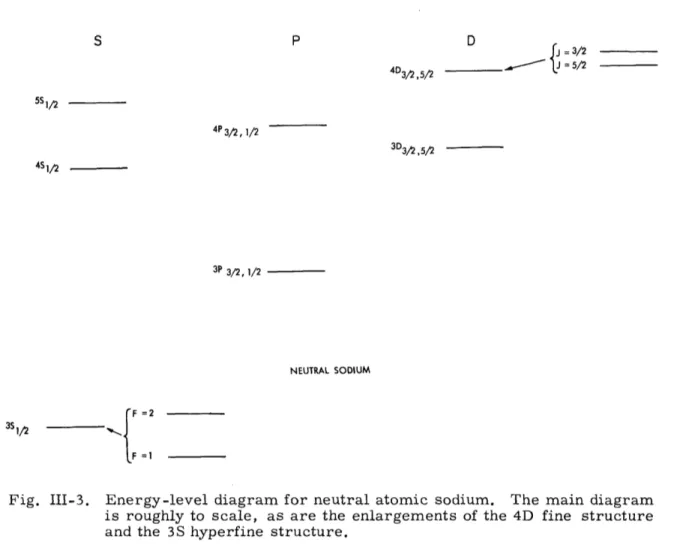III. ATOMIC RESONANCE AND SCATTERING
Prof. Daniel Kleppner Prof. David E. Pritchard
Jerome Apt III Gary M. Carter
Academic and Research Staff Dr. Theodore W. Ducas Graduate Students William E. Cooke Michael G. Littman Dr. Richard R. Freeman Dr. Edward M. Mattison William D. Phillips Francine Wright
A. TWO-PHOTON HIGH-RESOLUTION SPECTROSCOPY
Joint Services Electronics Program (Contract DAABO7-71-C-0300) Jerome Apt III, Theodore W. Ducas, David E. Pritchard
We have excited both the 4D and 5S states of neutral atomic sodium by simultaneous two-photon absorption directly from the 3S ground state. This is the first high-resolution two-photon spectroscopy performed in the visible region and the first to utilize continu-ous wave lasers. An atomic beam of ground-state sodium was excited by a Spectra-Physics System 580 single-mode tunable dye laser, and the resonance was detected by monitoring the decay fluorescence from the excited state. The experimental arrange-ment is shown in Fig. III-1.
SODIUM OVEN
HOT-WIRE BEAM MONITOR
Fig. III-1. Experimental apparatus. A mirror that reflects the laser beam back through the interaction region will be added to quadruple the signal and eliminate Doppler broadening caused by divergence of the atomic beam.
Since the linewidth observed in the experiment was 5 X 10- 3 cm-1 , we were able to resolve fully the fine structure of the 4 2D state by electronically sweeping the laser (around 17, 274 cm-1, half of the 3S-4D transition energy). The fine-structure splitting (around 17, 274 cm , half of the 3S-4D transition energy). The fine-structure splitting
(III. ATOMIC RESONANCE AND SCATTERING)
was measured by comparing the spacing between components of the observed spectrum (Fig. III-2) split by the 4D fine structure, A, with the spacing arising from the well-known hyperfine splitting of the 3S ground state, Aw. We measured Af =
. 0343 ±. 0002 cm . This error is roughly 1/10 that of any previous measurement of fine -structure splitting.
4D: j = 5/2 j 3/2 j 5/2 j 3/2 35: F=2 F=2 F=I F= . FREQUENCY AW I A A AW 2 2
Fig. I1-2. Detailed structure of the 3S - 4D two-photon transition (with fre-quency increasing to the right ~200 MHz/div). The levels involved in each of the four components of the transition are shown above the corresponding peaks and the spacing is shown below.
The transition rate for two-photon absorption is given by second-order time-dependent perturbation theory. If we take the perturbation to be H = i e A r, then the transition probability is proportional to
AZ Af 2
z (f
*Er
ik) (kl E l i)2
2 k
Rate oc (Laser Power)2 k
[(wki- fi/2)2 k+y/4]
where i and f refer to the initial and final states and the sum is taken over all inter-mediate states k, and wki (wfi) is the level spacing between the ground and interinter-mediate
(final) states.
The interesting feature of this expression is the resonance denominator, which allows high transition rates when one of the intermediate states is nearly midway between the
-1 initial and final states. In the case of our 3S - 4D transition, the 3P state is 350 cm-1 away from being halfway between the 3S and 4D levels (the sodium term diagram is
shown in Fig. I1-3), thereby allowing saturation of the two-photon transition with a rela-tively low power (2 X 103 W/cm2). (No direct excitation of the 3P state is produced by
(III. ATOMIC RESONANCE AND SCATTERING)
the laser when operating near the frequency wfi/2, since this is roughly 5 X 105 line-widths away from the resonance of the 3S - 3P transition.
4P 3/2, 1/2
4S 1/2
3P 3/2, 1/2
NEUTRAL SODIUM
Fig. 111-3. Energy-level diagram for neutral atomic sodium. The main diagram is roughly to scale, as are the enlargements of the 4D fine structure and the 3S hyperfine structure.
Two-photon spectroscopy is applicable, with improved optics and possibly signal averaging techniques, to systems in which the intermediate state is 1000-3000 cm1 from being halfway between the initial and final states. Thus this technique is well-suited to the precise spectroscopy of many systems in which levels have previously been inaccessible when using single-photon dipole transitions. Unlike stepwise excita-tion, this technique requires only a single laser, although a second cW laser (not tunable) at a different frequency can be utilized to extend the accessible frequency range consid-erably. QPR No. 113 =3/2 4D32,5 5/2 4D3/2,5/2 3s1/ F =2 F:=


